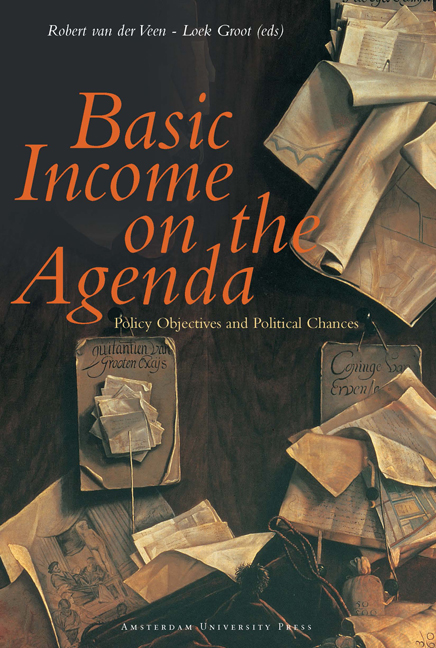Ups and Downs of Basic Income in Denmark
Published online by Cambridge University Press: 23 January 2021
Summary
Basic income has never seriously been on the Danish agenda of practical politics. On the contrary, in recent years the idea has been outright rejected, and political leaders have been careful to dissociate themselves from it. However, the very fact of the explicit statements against basic income in itself indicates that it has become a recurring issue in the Danish debate concerning social and labour market problems. And this is by no means accidental; for several reasons, basic income is an obvious theme in a Danish context. Both regarding the model to which the Danish welfare state belongs and the way in which social structures and welfare policies have developed, there are several aspects with striking affinities to a guaranteed, unconditional income to all citizens.
The most intensive and widespread discussions on basic income took place at the beginning of the 1990s, no doubt as a reflection of the preceding period, which to a considerable extent indicated a ‘creeping basic income’ or a ‘basic income through the back door’. However, a labour market reform in 1993 signalled a new departure in Danish welfare politics. A new philosophy of ‘activation’ or workfare was introduced, replacing the ‘passive’ line of the previous cash-benefit schemes. Since then, the labour market as well as social policies have developed within this new framework of activation, and the actual set-up of the Danish public transfers has definitely moved away from the basic income trajectory of the early 1990s. In that perspective, a Danish basic income reform, even a ‘creeping’ one, looks much less likely today than five or six years ago. Nonetheless, a valid assessment of the potential of and prospects for a basic income scheme in Denmark should also consider the development in popular values and preferences. In regard to that, there seem to be tendencies and inclinations which are more in accordance with the ideals of basic income than with the philosophy of workfare.
In the following, we shall offer an overview of the history of basic income from the perspective of the Danish welfare model, briefly characterized as an example of the Scandinavian universalisist model. After discussing the way in which the income maintenance system has developed during the last two decades or so, we portray the debate on basic income and conclude with the future chances for schemes like basic income in Denmark.
- Type
- Chapter
- Information
- Basic Income on the AgendaPolicy Objectives and Political Chances, pp. 257 - 267Publisher: Amsterdam University PressPrint publication year: 2000
- 2
- Cited by



